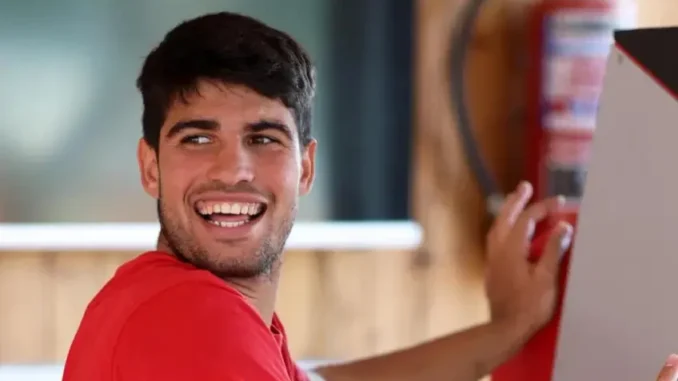
At just 22, Carlos Alcaraz has already carved out a legacy as one of tennis’s brightest stars, and renowned coach Patrick Mouratoglou is quick to point out what makes the Spaniard a singular phenomenon in the sport. While the modern tennis landscape is dominated by towering, lean players wielding massive serves and relentless power, Alcaraz stands apart as an exception, blending explosive athleticism with a physique that defies the current trend. Mouratoglou’s recent analysis highlights how Alcaraz’s unique body type and versatile game have propelled him to five Grand Slam titles, setting him on a trajectory to challenge the legacies of legends like Roger Federer, Rafael Nadal, and Novak Djokovic.
Mouratoglou, who has coached Serena Williams to 10 Grand Slam titles and currently guides Naomi Osaka, shared his insights in a captivating Instagram video, noting a seismic shift in the physical profile of top male players. “Clearly there is a change in terms of body type of the tennis player for the last years. They are taller and taller, they are thinner and thinner,” he observed. “Look at the top guys, I mean there is one exception, Carlos Alcaraz, but all the other guys, whether it’s Djokovic, Sinner, Zverev, Tsitsipas, Medvedev, I mean all the guys are really thin, very tall.” This new archetype, exemplified by players like Jannik Sinner and Alexander Zverev, leverages height—often exceeding 6 feet 1 inch—and long limbs to generate “huge serves, huge power,” as Mouratoglou put it. He explained that longer arms allow these players to accelerate the ball at blistering speeds, a hallmark of the modern game where 26% of the top 50 players stand above 6 feet 5 inches.
Alcaraz, at 6 feet, bucks this trend with a more compact, muscular build that fuels his all-court dominance. Mouratoglou emphasized that this physical distinction doesn’t hinder Alcaraz but enhances his game, making him a versatile threat on every surface. “Carlos can do anything,” Mouratoglou said in a separate interview, praising Alcaraz’s ability to “play flat, slice, his drop shots are unbelievable, his net game is unbelievable, he can do serve and volley, he serves incredibly well for a guy of his height and physically is a beast.” This versatility was on full display in 2024, when Alcaraz captured both Wimbledon and the French Open, including a marathon five-hour, 29-minute Roland Garros final against Sinner, the longest in the tournament’s history. His ability to outlast opponents with his movement, unleash a “deadly” forehand, and master the drop shot—particularly on clay—sets him apart, as Mouratoglou noted years ago when he declared Alcaraz an all-court player, not just a clay specialist like his compatriot Nadal.
The Spaniard’s recent season, while not flawless, underscores his resilience. After a quarter-final loss to Djokovic at the 2025 Australian Open and early exits in Qatar and Miami, Alcaraz bounced back with a title in Rotterdam, defeating Alex de Minaur 6-4, 3-6, 6-2. His Wimbledon campaign ended in a four-set final loss to Sinner, a match Mouratoglou described as a testament to Alcaraz’s mental fortitude despite “ups and downs.” “When Carlos is at his best, there is a real match, and I’m not sure who is going to win,” Mouratoglou said, comparing Alcaraz’s riskier, error-prone style to Sinner’s metronomic consistency. Alcaraz’s 6-4 head-to-head edge over Sinner, including three wins in 2024, proves his ability to rise to the occasion in high-stakes battles.
Mouratoglou also highlighted Alcaraz’s serve as a key weapon, noting its fluidity in a February 2025 Instagram post. “I see two things on that photo of Carlos Alcaraz,” he said. “First thing, the right leg which is going so far up, and the second thing I see is his left arm, which is going so far back also after the serve. What does it say? It says one big thing, how loose he is, how relaxed.” This lack of muscular tension allows Alcaraz to generate power and maintain stamina, a critical factor in his epic matches. However, Mouratoglou has cautioned that Alcaraz’s physical intensity comes with risks, pointing to instances of cramping in major matches. “If you look at Roger, Rafa, & Novak, have you seen them cramp once in a match? All their careers? He cramped many times already, only at 20,” he posted on X, urging Alcaraz to prioritize a schedule that ensures mental and physical rest.
Alcaraz’s withdrawal from the 2025 Canadian Open, citing “small muscles issues” and the need to recover for the US Open, reflects this cautious approach. “After many consecutive weeks of competition without rest, I will not be able to play in Toronto this year,” he shared on X, apologizing to fans. Mouratoglou’s analysis suggests this decision aligns with Alcaraz’s need to manage his intense playing style, which, while a strength, demands careful pacing to avoid burnout. As the US Open approaches, where Alcaraz won his first Grand Slam in 2022 at age 19, all eyes are on whether he can leverage his exceptional physicality and skill to reclaim the title.
Mouratoglou’s praise extends beyond Alcaraz’s physical gifts to his mental approach, though he’s noted its complexities. In a Netflix documentary, Alcaraz admitted to fearing tennis becoming an obligation, a sentiment his coach Juan Carlos Ferrero said clashes with the team’s work ethic. Mouratoglou called this “unusual,” noting, “Most other players would not say it… Maybe the fact that he verbalised it will put more pressure on him.” Yet, he sees potential in Alcaraz’s candor, suggesting it could relieve pressure if channeled correctly. As Alcaraz navigates these challenges, Mouratoglou’s belief in his “better level” than even Federer’s prime underscores the Spaniard’s potential to redefine tennis, proving that in a sport of giants, Alcaraz’s unique blend of power, finesse, and heart makes him the ultimate exception.
Leave a Reply